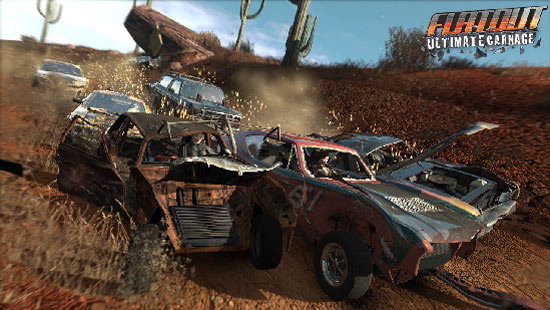You may be thinking, “With all the huge games at E3 this year,
Well, young ones (*patting you on the head*), I met with one of the producers of the game from publisher Empire Interactive and was really impressed with him, his company, and, most importantly, the game (as of now, exclusive for the Xbox 360).
Empire Interactive is a small publishing company based in the
After meeting with some representatives from the company and playing the game, I felt supporting it as much as possible would be the right thing to do in this ridiculously competitive videogame industry that has a habit of keeping the little man down.
Hit the jump to fight the man (!) and give a surprisingly solid little racer a chance to breathe in an
If you are familiar with the FlatOut series, you know it is very similar to Burnout in that it is a heavy arcade racer that actually rewards the player for making stupendous and daring crashes. As you drive through a level you collect points for doing things like wrecking other cars and driving through glass-walled buildings.
All of these points can be used to unlock new cars (each one crazier than the next, including a huge, yellow school bus), tracks, and game modes.
Of course, all of this can be accomplished in a traditional one-player mode or on-line over Xbox Live with full leader boards, achievements, etc.
While all of this is fun, what makes this game stand out, seriously, way above the competition is its strong physics engine and over-the-top uses for it.
In all the FlatOut games (and especially this one) there has been the ability to destroy, literally, everything in the level. In fact, Empire promises that FlatOut: Ultimate Carnage will be the most destructive racing game ever (with an average of 8,000 destructible objects per track). After playing for an extended period of time, I have to believe that may be true.
And not only can everything be destroyed; once any object is hit it reacts so realistically to the environment around it. At one point, my car drove through a junkyard containing a huge pile of old tires. The car that I was controlling slammed into this pile and the tires went flying, each individual tire (of which there were near a hundred) reacting independent from the others.
What was already incredible was made even more so when the producer actually paused the game, opened his development kit, and replayed the sequence for me in slow motion. Upon seeing the crash again, I noticed that not only was each tire a separate object, but every tread was rendered differently, even producing a unique set of shadows. The detail was very impressive, especially considering this scene lasts for less than a second.
After racing for a while, Empire introduced me to the most fun (and ridiculous) use for their acclaimed physics engine. Using advanced “rag doll” technology, one game mode lets you drive your car down a straight course, slam on your brakes, and let your driver break through the front window, fly through the air, and land on a target hundreds of feet down the course. Seeing it in motion is a little sick, a little twisted, but pretty darn fun. Even though I felt guilty sending these poor drivers to their deaths, the numerous challenges involving this mechanic were too original to pass up.
Even though I am not a huge fan of driving games I had a lot of fun with FlatOut: Ultimate Carnage. The game looked great (visually on par with something like Burnout), offered a load of content, and was a blast to play. If you are looking for something wholly original, definitely check out FlatOut: Ultimate Carnage when it is released in the








